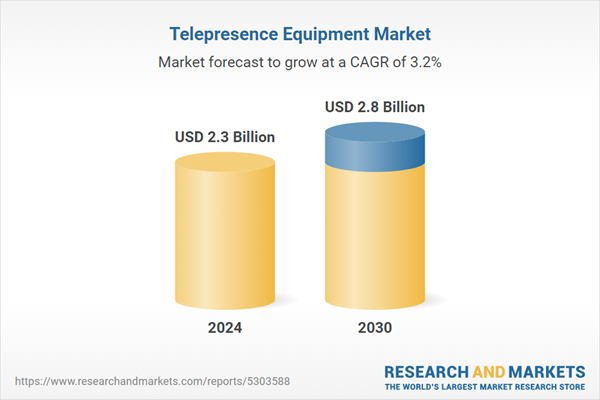The global market for Telepresence Equipment was valued at US$2.3 Billion in 2024 and is projected to reach US$2.8 Billion by 2030, growing at a CAGR of 3.2% from 2024 to 2030. This comprehensive report provides an in-depth analysis of market trends, drivers, and forecasts, helping you make informed business decisions. The report includes the most recent global tariff developments and how they impact the Telepresence Equipment market.
Segments: Organization Size (Large Enterprises, Medium Enterprises, Small Enterprises).
Geographic Regions/Countries: World; United States; Canada; Japan; China; Europe (France; Germany; Italy; United Kingdom; and Rest of Europe); Asia-Pacific; Rest of World.
The analysts continuously track trade developments worldwide, drawing insights from leading global economists and over 200 industry and policy institutions, including think tanks, trade organizations, and national economic advisory bodies. This intelligence is integrated into forecasting models to provide timely, data-driven analysis of emerging risks and opportunities.
Global Telepresence Equipment Market - Key Trends and Drivers Summarized
How Is Telepresence Equipment Revolutionizing Remote Communication?
Telepresence equipment comprises advanced communication technologies designed to create realistic, immersive virtual meeting experiences. This equipment includes high-definition video conferencing systems, interactive displays, microphones, cameras, and software platforms that support seamless, real-time communication between remote participants. It is used across sectors like corporate enterprises, healthcare, education, and government to enable virtual meetings, consultations, training, and collaboration. As remote work, virtual learning, and telehealth continue to expand, telepresence equipment has become crucial in maintaining effective communication, improving decision-making, and reducing travel costs.What Are the Key Segments in the Telepresence Equipment Market?
Key types include immersive telepresence, personal telepresence, and room-based telepresence systems, with room-based telepresence systems holding the largest market share due to their widespread use in corporate boardrooms, healthcare facilities, and educational institutions. Components include displays, cameras, microphones, software, and other peripherals, with displays dominating the segment as they enable clear, high-resolution visuals that enhance virtual interactions. End-users comprise corporate enterprises, healthcare providers, educational institutions, and government organizations, with corporate enterprises representing a significant share driven by the need for effective virtual communication, global collaboration, and cost reduction.How Is Telepresence Equipment Integrated Across Industries?
In the corporate sector, telepresence equipment facilitates virtual board meetings, team collaborations, and client presentations, supporting decision-making and maintaining productivity across geographically dispersed teams. In healthcare, telepresence systems enable virtual consultations, remote patient assessments, and training of medical staff, improving access to care and medical education. Educational institutions use telepresence technology for virtual classrooms, remote lectures, and interactive learning, ensuring continuous education despite geographical limitations. Additionally, government agencies deploy telepresence systems for remote governance, crisis management, and cross-departmental coordination, enhancing operational efficiency and reducing travel costs.What Factors Are Driving the Growth in the Telepresence Equipment Market?
The growth in the Telepresence Equipment market is driven by several factors, including increasing demand for remote communication tools, advancements in video conferencing technology, and rising adoption of virtual collaboration platforms. Innovations like AI-enhanced video quality, improved bandwidth efficiency, and real-time language translation have supported broader applications in corporate, healthcare, and education sectors. The focus on reducing travel expenses, improving collaboration, and supporting hybrid work models has further fueled demand, as telepresence equipment provides high-quality communication solutions. Additionally, expanding remote work trends, increasing global collaborations, and growing investments in digital infrastructure have contributed to market growth, encouraging the adoption of telepresence technology across industries.Report Scope
The report analyzes the Telepresence Equipment market, presented in terms of units. The analysis covers the key segments and geographic regions outlined below.Segments: Organization Size (Large Enterprises, Medium Enterprises, Small Enterprises).
Geographic Regions/Countries: World; United States; Canada; Japan; China; Europe (France; Germany; Italy; United Kingdom; and Rest of Europe); Asia-Pacific; Rest of World.
Key Insights:
- Market Growth: Understand the significant growth trajectory of the Large Enterprises segment, which is expected to reach US$1.9 Billion by 2030 with a CAGR of a 3.1%. The Medium Enterprises segment is also set to grow at 3.7% CAGR over the analysis period.
- Regional Analysis: Gain insights into the U.S. market, valued at $630.3 Million in 2024, and China, forecasted to grow at an impressive 3.2% CAGR to reach $452.9 Million by 2030. Discover growth trends in other key regions, including Japan, Canada, Germany, and the Asia-Pacific.
Why You Should Buy This Report:
- Detailed Market Analysis: Access a thorough analysis of the Global Telepresence Equipment Market, covering all major geographic regions and market segments.
- Competitive Insights: Get an overview of the competitive landscape, including the market presence of major players across different geographies.
- Future Trends and Drivers: Understand the key trends and drivers shaping the future of the Global Telepresence Equipment Market.
- Actionable Insights: Benefit from actionable insights that can help you identify new revenue opportunities and make strategic business decisions.
Key Questions Answered:
- How is the Global Telepresence Equipment Market expected to evolve by 2030?
- What are the main drivers and restraints affecting the market?
- Which market segments will grow the most over the forecast period?
- How will market shares for different regions and segments change by 2030?
- Who are the leading players in the market, and what are their prospects?
Report Features:
- Comprehensive Market Data: Independent analysis of annual sales and market forecasts in US$ Million from 2024 to 2030.
- In-Depth Regional Analysis: Detailed insights into key markets, including the U.S., China, Japan, Canada, Europe, Asia-Pacific, Latin America, Middle East, and Africa.
- Company Profiles: Coverage of players such as Array Telepresence, Avaya, Inc., Cisco Systems, Inc., Digital Video Enterprises, HaiVision and more.
- Complimentary Updates: Receive free report updates for one year to keep you informed of the latest market developments.
Some of the 36 companies featured in this Telepresence Equipment market report include:
- Array Telepresence
- Avaya, Inc.
- Cisco Systems, Inc.
- Digital Video Enterprises
- HaiVision
- HP Inc.
- Huawei Technologies Co. Ltd.
- Polycom, Inc.
- Sony Corporation
- Videonations Limited (Nycomm Communications Group)
- Vidyo, Inc.
- ZTE Corporation
Tariff Impact Analysis: Key Insights for 2025
Global tariff negotiations across 180+ countries are reshaping supply chains, costs, and competitiveness. This report reflects the latest developments as of April 2025 and incorporates forward-looking insights into the market outlook.The analysts continuously track trade developments worldwide, drawing insights from leading global economists and over 200 industry and policy institutions, including think tanks, trade organizations, and national economic advisory bodies. This intelligence is integrated into forecasting models to provide timely, data-driven analysis of emerging risks and opportunities.
What’s Included in This Edition:
- Tariff-adjusted market forecasts by region and segment
- Analysis of cost and supply chain implications by sourcing and trade exposure
- Strategic insights into geographic shifts
Buyers receive a free July 2025 update with:
- Finalized tariff impacts and new trade agreement effects
- Updated projections reflecting global sourcing and cost shifts
- Expanded country-specific coverage across the industry
Table of Contents
I. METHODOLOGYII. EXECUTIVE SUMMARY2. FOCUS ON SELECT PLAYERSIII. MARKET ANALYSISIV. COMPETITION
1. MARKET OVERVIEW
3. MARKET TRENDS & DRIVERS
4. GLOBAL MARKET PERSPECTIVE
UNITED STATES
CANADA
JAPAN
CHINA
EUROPE
FRANCE
GERMANY
ITALY
UNITED KINGDOM
REST OF EUROPE
ASIA-PACIFIC
REST OF WORLD
Companies Mentioned (Partial List)
A selection of companies mentioned in this report includes, but is not limited to:
- Array Telepresence
- Avaya, Inc.
- Cisco Systems, Inc.
- Digital Video Enterprises
- HaiVision
- HP Inc.
- Huawei Technologies Co. Ltd.
- Polycom, Inc.
- Sony Corporation
- Videonations Limited (Nycomm Communications Group)
- Vidyo, Inc.
- ZTE Corporation
Table Information
| Report Attribute | Details |
|---|---|
| No. of Pages | 92 |
| Published | April 2025 |
| Forecast Period | 2024 - 2030 |
| Estimated Market Value ( USD | $ 2.3 Billion |
| Forecasted Market Value ( USD | $ 2.8 Billion |
| Compound Annual Growth Rate | 3.2% |
| Regions Covered | Global |









